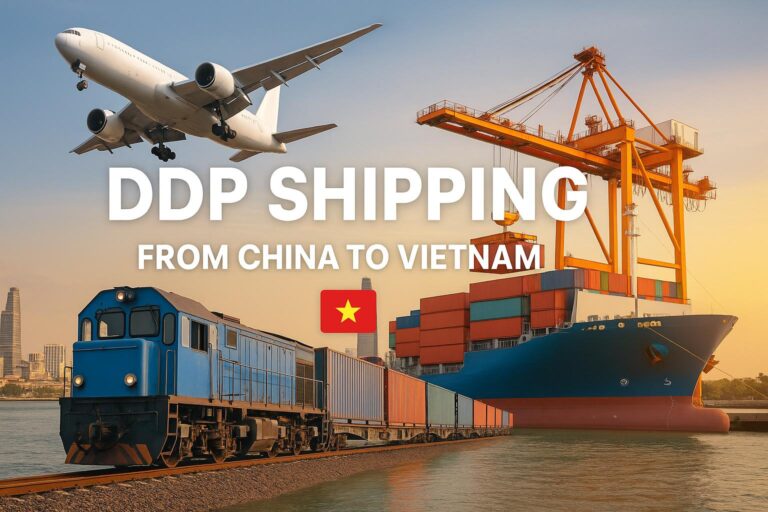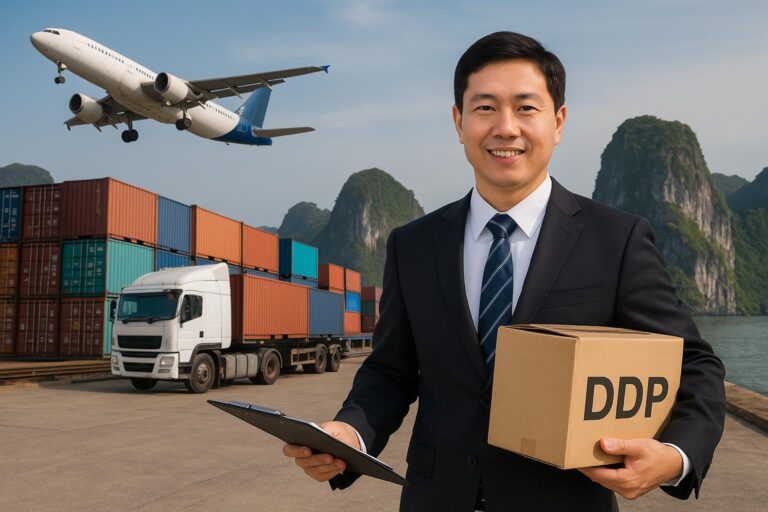Why Choose DDP Shipping from China to Vietnam
DDP shipping from China to Vietnam is quickly becoming the preferred method for importers seeking a simplified and predictable international shipping solution. By using Delivered Duty Paid (DDP), all logistics responsibilities are transferred to the freight forwarder—including freight charges, customs clearance, import duties, and final door to door delivery.
This shipping method is especially popular among eCommerce sellers, small businesses, and those without the experience or capacity to handle international trade paperwork and taxes. With Vietnam’s rapid growth in cross-border commerce, selecting the right shipping method is critical to stay competitive.

What Is DDP Shipping and How It Works
Delivered Duty Paid (DDP) is one of the Incoterms rules used in international shipments, where the seller is responsible for the entire shipping process, including export and import customs clearance, delivery fees, and customs duties.
Under the DDP agreement, the seller arranges transportation from their warehouse in China to the buyer’s designated address in Vietnam—without requiring the buyer to interact with customs procedures, arrange transport, or pay unexpected shipping costs. For many, this makes DDP a stress-free and transparent shipping solution.
Why Choose DDP Shipping to Vietnam
One of the main reasons businesses opt for DDP shipping to Vietnam is the convenience of having everything managed by a single freight forwarder. By choosing DDP, you eliminate the need to coordinate multiple service providers or navigate the complexities of customs clearance procedures yourself.
DDP is ideal for importers who:
Lack experience with international logistics
Want predictable and transparent shipping costs
Require door to door delivery with minimal delays
Prefer a trusted partner to handle customs duties and documentation
For many importers, DDP provides peace of mind, reduces delays at borders, and enables smooth international shipping without unexpected costs or legal complications.
Air Freight vs. Sea Freight for DDP Shipments to Vietnam
When using DDP shipping, both air freight and sea freight are viable options—each suited for different needs depending on your timeline, cargo volume, and budget.
Mode | Best For | Transit Time | Cost |
|---|---|---|---|
Air Freight | Urgent, high-value, light shipments | 3–7 days | Higher |
Sea Freight | Large volume, non-urgent shipments | 10–22 days | More cost-effective |
- Air freight from China to Vietnam is faster but comes with weight and volume restrictions. It’s a smart choice for electronics, fashion items, or small parcels with tight delivery windows.
Sea freight to Vietnam is suitable for bulk shipments, large or heavy items, or those requiring economical transportation. Carriers use major Chinese seaports and deliver to ports such as Hai Phong or Ho Chi Minh City.
Sometimes, freight forwarders offer combined air and sea freight options for a balance between cost and speed—especially for split shipments or seasonal stock.
Step-by-Step DDP Shipping Process from China to Vietnam
Understanding the shipping process under DDP terms helps importers know what to expect at each stage. Here’s how the entire shipping process typically works:
Quote & Booking: The freight forwarder provides a DDP quote based on cargo type, shipping method, and destination.
Pickup & Export Customs Clearance: The goods are picked up in China, and the forwarder handles export customs clearance with proper documentation such as a commercial invoice and packing list.
Main Transport: Goods are shipped via air freight or ocean freight shipments depending on the agreed route.
Import Customs Clearance in Vietnam: The freight forwarder works with a customs broker in Vietnam to clear the goods, pay applicable customs duties, and handle inspection if needed.
Final Delivery: Goods are delivered directly to your warehouse, shop, or distribution center—this is the essence of door to door shipping under DDP.
This streamlined approach ensures you avoid paperwork errors, delays, or shipment delays caused by incomplete customs documents.
Required Documents for DDP Shipping from China to Vietnam
While the freight forwarder handles most of the documentation under a DDP shipping agreement, it’s essential to understand the core paperwork involved in international trade:
Commercial Invoice: Contains product details, value, and terms of sale—crucial for both export customs clearance in China and import customs clearance in Vietnam.
Packing List: Lists packaging information like quantity, dimensions, and weight and volume—important for assessing container load suitability.
Air Waybill or Bill of Lading: Provided by the shipping company or airline; serves as the transport contract and tracking reference.
Certificates (if applicable): For certain regulated goods, a test or inspection certificate or license may be required.
Accurate and proper documentation is essential to avoid shipment delays and ensure smooth logistics operations at the border.
How Much Does DDP Shipping from China to Vietnam Cost?
The shipping costs for DDP service depend on several variables:
Mode of transport: Air freight is more expensive than sea freight
Weight/volume: Charges are calculated based on actual or chargeable weight
Destination address: Remote areas in Vietnam may incur additional door to door transportation fees
Cargo type: Packaging materials, handling needs, and regulations impact total costs
Example Costs (Reference Only) | 100kg (Air Freight) | 1 CBM (Sea Freight) |
|---|---|---|
Guangzhou → Hanoi (DDP Air) | $3.50–$4.50/kg | – |
Shenzhen → Ho Chi Minh (DDP Sea) | – | $100–$180/CBM |
Tip: Always request a quote that includes all shipping fees, taxes, and customs—so you’re not surprised by hidden charges. A reliable freight forwarder will help you choose the most cost-effective solution based on your cargo’s profile.
To explore detailed shipping costs and delivery times from China to other countries, you can click below:
Transit Time for DDP Shipping from China to Vietnam
Timely delivery is often a priority when importing goods. Here’s a general breakdown of transit times for DDP shipping:
Route | Transport Type | Transit Time |
|---|---|---|
Shenzhen → Hanoi | Air Freight | 3–5 days |
Guangzhou → Ho Chi Minh City | Air Freight | 4–6 days |
Ningbo → Hai Phong | Sea Freight | 10–14 days |
Shanghai → Ho Chi Minh (LCL) | Sea Freight | 12–18 days |
Factors affecting delivery time include:
Carrier availability and shipping schedules
Port congestion or customs processing delays
Holidays in China or Vietnam
Type of international shipping used (express or economy)
A well-coordinated DDP shipment ensures quick transit and reliable arrival, even during peak seasons. Your freight forwarder should provide a realistic lead time including customs clearance.
Major Chinese Ports and Airports for DDP Shipping to Vietnam
China’s extensive export network offers multiple gateways for DDP shipping to Vietnam. Your choice of origin point depends on your supplier’s location, shipping method, and transit time needs.
Popular Seaports for DDP Sea Freight:
Shenzhen (Yantian, Shekou) – Closest to northern Vietnam, ideal for LCL shipments
Guangzhou (Nansha) – Efficient processing and competitive sea carriers charge
Shanghai – Major global hub, suitable for high-volume container load exports
Ningbo – Excellent infrastructure and short route to Hai Phong Port
Major Airports for DDP Air Freight:
Guangzhou Baiyun International Airport (CAN)
Shenzhen Bao’an International Airport (SZX)
Shanghai Pudong International Airport (PVG)
Choosing the right origin can optimize shipping routes, reduce costs, and ensure timely delivery. A knowledgeable freight forwarder can help identify the most efficient route based on cargo type and shipping method.
Tips for Choosing the Right Freight Forwarder for Vietnam Shipping
A successful DDP shipment depends heavily on selecting a qualified freight forwarder who understands the nuances of Vietnam shipping and customs clearance procedures.
Here’s what to look for:
Experience in DDP to Vietnam: Not all forwarders are familiar with Vietnam’s import policies
Own customs broker team: Ensures faster customs clearance and less dependency on third parties
Transparent pricing: Should break down all costs, including customs duties, shipping fees, and last-mile delivery
Offers both air freight and sea freight options
Ability to tailor shipping solutions based on your cargo and urgency
The right freight forwarder will act as your logistics partner—providing flexible options, smooth communication, and proactive problem-solving across all logistics operations.

Common Challenges in DDP Shipping from China to Vietnam (And How to Avoid Them)
Even with the simplicity of DDP shipping, certain issues can still arise. Being aware of these risks and knowing how to respond can save time and money.
- Challenge: Incomplete or inaccurate commercial invoices
Solution: Work with your supplier and forwarder to ensure consistent, accurate documents. - Challenge: Customs inspection or reclassification
Solution: Use a freight forwarder with strong customs broker support in both China and Vietnam to reduce risk of fines or shipment delays. - Challenge: Weight and volume restrictions in air shipping
Solution: Pre-calculate chargeable weight using a CBM calculator and choose the best mode (air/sea). - Challenge: Using an unreliable shipping company or poor handling of door shipping
Solution: Only work with vetted forwarders offering guaranteed door to door delivery and insurance options.
With a professional team and clear planning, you can navigate potential bottlenecks in the customs process and ensure a smoother international shipping experience.
Conclusion: Is DDP the Best Method to Ship from China to Vietnam?
For many importers, DDP shipping from China to Vietnam is the most practical and cost-effective method to simplify operations and reduce risk. It eliminates the need to navigate customs procedures, pay unexpected fees, or arrange multiple transport stages.
Whether you’re using air freight for faster express freight deliveries or ocean freight for more economical bulk shipments, DDP ensures that your goods arrive safely and legally—right to your destination’s door. It’s especially beneficial for companies handling international shipments with limited logistics resources.
That said, your shipping method depends on your product type, budget, and delivery schedule. DDP can be applied across door to door shipping, railway freight, or multi-modal transport solutions.
Working with a reliable freight forwarder helps you tailor the most efficient and transparent shipping solution for your needs.
Frequently Asked Questions (FAQs)
Q1: What’s included in DDP shipping from China to Vietnam?
A: DDP includes freight charges, customs clearance, import taxes/duties, and final door shipping to your address in Vietnam. You don’t need to handle any part of the process.
Q2: Is air freight or sea freight better for DDP shipping?
A: Air freight is faster but more expensive—ideal for lightweight goods. Sea freight is slower but more affordable—ideal for larger and heavier shipments. The best shipping method depends on your delivery timeline and budget.
Q3: How are DDP shipping costs calculated?
A: Costs are based on cargo type, weight and volume, delivery location, and international logistics conditions. Use a CBM calculator or consult a forwarder for precise rates.
Q4: Can I use DDP for small eCommerce orders to Vietnam?
A: Yes! Many shipping companies and forwarders offer DDP express shipping or LCL options for low-volume items. It’s ideal for online sellers and cross-border platforms.
Q5: Does DDP shipping support rail freight or multimodal delivery?
A: Absolutely. Some providers offer railway freight from southern China to northern Vietnam or combine air and sea freight for hybrid shipping solutions that balance speed and cost.

